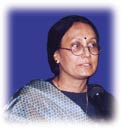 Pariwar
Sewa Sanstha (PSS), a Non-Government organization working for reproductive health
of men and women in 32 centres all over India launched Ecroz in 1989, under the
social marketing umbrella of Government of India. Ecroz is a combination pill
containing 0.30 mg NG and 0.03 mg EE. The same was used in appropriate doses as
EC pill. During training, we talked about the benefits of COC and one of these
was use as Emergency Contraception, which was welcomed by clients. A multipronged
approach was found more useful and a lot of promotional material was produced.
Training of clinical team, CSM team and outreach team through speedy life education
as well as training of IMA trainers was done and special training of trainers
was conducted in Himachal Pradesh. Pariwar
Sewa Sanstha (PSS), a Non-Government organization working for reproductive health
of men and women in 32 centres all over India launched Ecroz in 1989, under the
social marketing umbrella of Government of India. Ecroz is a combination pill
containing 0.30 mg NG and 0.03 mg EE. The same was used in appropriate doses as
EC pill. During training, we talked about the benefits of COC and one of these
was use as Emergency Contraception, which was welcomed by clients. A multipronged
approach was found more useful and a lot of promotional material was produced.
Training of clinical team, CSM team and outreach team through speedy life education
as well as training of IMA trainers was done and special training of trainers
was conducted in Himachal Pradesh.
PSS has now
started a structured programme for EC service delivery for the last 2 years. We
feel that post-coital pill does not convey the right meaning as neither does it
tell about the correct timing of use, nor that it can be used only in an emergency.
EC service delivery under PSS is being done by doctors including specialists,
GPs, trained nurses, midwives, counsellors as well as community health workers.
This service is provided in all healthcare facilities, hospitals, nursing homes
and all reproductive health clinics with referral facility, social marketing programmes
and commercial outlets. All women in reproductive age group, specially adolescents
who lack initiative to visit a clinic and are afraid of publicity or provider’s
attitudes are being provided EC services. Most
important points considered for EC service delivery included increasing awareness
and accessibility. Non-availability of the product in India is causing a lot of
problems. ICMR and DCI have not been permitting production. Ministry of Health
is keenly interested but permission has not been given yet. Not having a brand
is creating a problem and confusion. We have Levo as 1+1, Yuzpe as 2+2, COC as
4+4 regime. There are a lot of logistic problems, otherwise we will not know which
pills are being used for what purpose. PSS has selected and registered “NOPREG”
as brand name. The packaging prototype is ready, manufacturer has been identified,
but permission to brand is awaited. Meanwhile, it was agreed by the Ministry of
health that PSS could use labelled bottles of 8 tables of Ecroz in the clinics.
Till the end of November 2000 a total of 93 women had been provided with Emergency
Contraception by PSS. This includes “ECROZ” to 84 (90.3%), Levonorgestrel “Norlevo”
to 6 (6.5%) and CuT IUD to 3 (3.2%). All clients
took 1st dose at the clinic and 2nd dose at home 12 hours after the 1st dose.
antiemetics were given to 78% of “ECROZ” EC users. Only 1 client vomited 2 hours
after the second dose. None of the other clients had any problems. One woman in
the Norlevo group had her period one week early. there were no pregnancies.
One-line advertisements were put in newspapers. Patients came following referral
by friends (30%), chemists (3%), relatives (3%), doctors (7%) or after reading
from newspapers (8%), 12% patients came to clinic directly. Many came after a
lunch session. Majority (65%) came within 24
hours, 28% between 25-48 hours while 6% came between 49-72 hours. Only one woman
came after 72 hours, and she was provided with CuT. Their socio-demographic characters
are listed in Table 1. Table-I
: Socio-Demographic characteristics of EC users
I. Age distribution
Ť 20 years – 17% 21-25 years – 55%
26-30 years – 18% 31-35 years – 9%
36-40 years – 1%
II. Education status Nil – 4%
Middle – 4% Secondary – 23%
Postgraduate – 13% III. Parity
Nulliparous – 67% Parous – 33%
IV. Previous use of contraception
No method – 26% Condom – 60%
OCP – 10% IUD – 4% V.
Reason for requesting EC No contraception
– 58% Condom tear/slip – 32%
Ineffective withdrawal – 9% IUD expelled – 1%
Most clients requesting for EC were newly- married, but not wanting to conceive.
By providing them EC, PSS achieved the motto of having “pregnancy by choice,
rather than by chance”. |